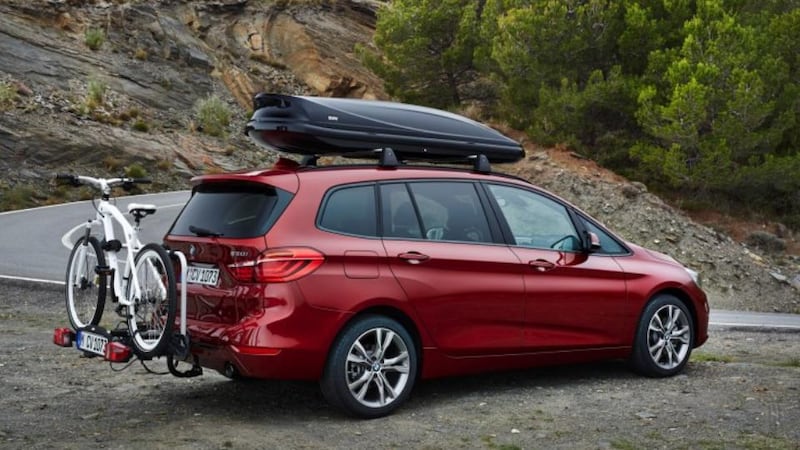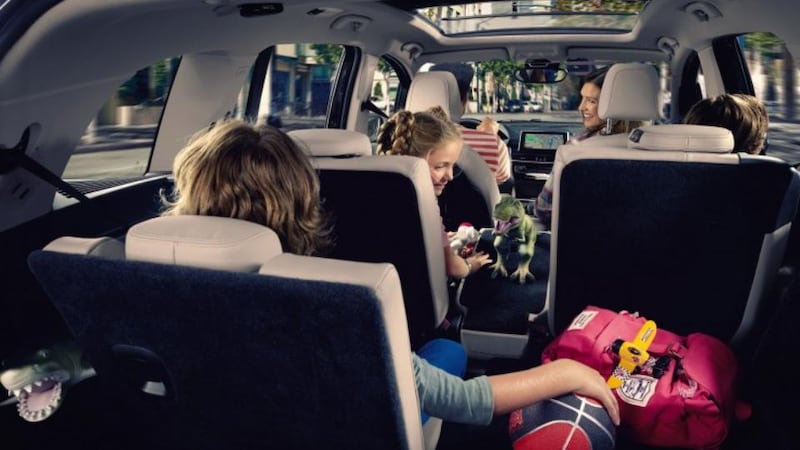The arguments about BMW’s right to build the front-drive 2-Series Active Tourer have barely died down and now this.
If the internet forums bristled about the first front-drive BMW, watch them catch fire when they see BMW's first front-drive, seven-seat family production car.
BMW is claiming the 2-Series Gran Tourer is the first premium compact model in the world to offer seven seats and it does it on a stretched version of the UKL architecture that also underpins the new MINI three- and five-door models.


The car will arrive in Irish showrooms in June with prices starting at €35,940 for the 1.5-litre three-cylinder petrol 218i. The entry-level diesel – also a 1.5-litre three-cylinder unit – will start at €36,580 for the 216d.
The 4.6-metre 2-Series Gran Tourer is 214mm longer than the Active Tourer and that helps it offer far greater interior space. Sitting on a 2,780mm wheelbase, the 2-Series Gran Tourer shares its little brother’s 1,800mm overall width.
Another area where it differs significantly is in height, where the 2-Series Gran Tourer is, at 1,608mm, 53mm taller than its sibling.
Besides allowing it to carry seven seats, the bigger dimensions boost the luggage capacity from the Active Tourer’s 560 litres to 645 litres and from the Active Tourer’s maximum capacity (with the seats folded down) of 1,820 litres to 1,905 litres.
The new car, which will make its public debut at next month’s Geneva Motor Show, uses the same engines, gearboxes and suspension systems as the Active Tourer.
That means a choice of five turbocharged engines, from a 1.5-litre three-cylinder turbo diesel to a choice of 2.0-litre turbo diesel and from a 1.5-litre turbo three-cylinder petrol motor to a 2.0-litre turbo petrol four cylinders.
Blistering acceleration
The most powerful of the 2-Series Gran Tourer’s motors will be houses across the nose of the 220i, delivering 141kW of power and 280Nm of torque. While blistering acceleration scarcely seems the point of this sort of car, the 220i version will manage to get itself to 100km/h in 7.7 seconds, which seems quicker than it needs to be.
It’s a fair bit sharper than its 100kW little brother, the three-cylinder 218i, which manages the same sprint, eventually, in 9.5 seconds. Still, the little engine delivers an NEDC combined economy figure of 5.1 litres/100km to best its faster sibling by a full 1.1 litres.
It helps that the 218i is the lightest of all the 2-Series Gran Tourer models, weighing 1,395kg to be 60kg lighter than the 220i.
The diesels are heavier again, with the three-cylinder 216d weighing 1,420kg (DIN), the 218d weighing 1,450kg and the 220d adding a significant 115kg despite carrying the same power train hardware as the 218d. But it does use 17-inch wheels and tyres to be plus one to the slower cars . . .
The trade-off is in acceleration, where the 140kW/400Nm 220d gets to 100km/h in 7.6 seconds despite the extra mass. The 330Nm 218d is considerably slower, at 9.3 seconds, while the 216d is slower again at 11.1 seconds. Yes 11.1 seconds from a modern BMW.
Quickest
It tops out at 192km/h, too, which is slower than the 205km/h of the 218d and far slower than the 220d’s 218km/h. The petrol 220i is the quickest of them, topping out at 223km/h.
The 270Nm three-cylinder diesel is at least frugal on the NEDC combined test, with a combined consumption figure of 3.9 litres/100km to boast emissions of just 104 grams of CO2 per kilometre.
The 218d is slightly thirstier, though still uses an acceptable 4.3 litres/100km while the flagship diesel posts 4.9 litres/100km.
While six-speed manual transmissions will be standard (at least in Europe) across the range, the three-cylinder versions will have optional six-speed automatics and four-cylinder buyers can choose an eight-speed auto. The 220d justifies some of its added heft by using the eight-speed auto as standard equipment, while it adds 30kg to the 218d and the 220i.
BMW has tried to maximise the car’s interior flexibility by giving the rear seats the ability to slide fore and aft by 130mm, while it divides into 40:20:40 configuration to fold flat at the touch of a button (or buttons). The rear seat is claimed to be wide enough to carry three baby capsules or seats simultaneously.
The optional third row of seats can be folded flat into the boot floor when it’s not in use.
It is also trialling an app especially for entertaining children. Available in Germany only (for the moment), the myKIDIO app sources and plays kid-friendly (and appropriate) content, from movies to TV shows to audio books, to be played on a tablet attached to the rear of the front seat. Or to the rear of the second row of seats.
Multimedia screen
The front-seat occupants are always in charge of what’s being shown to the children and the content description is always displayed on the front multimedia screen. It can also be changed from the front on the iDrive controller. On the flip side, children in the rear can also access on-board computer information, such as speed, distance travelled, how many kilometres remain on the drive or the outside temperature.
All models of the car have a 6.5-inch multimedia display as standard equipment, plus Bluetooth and the ability to stream live music or podcasts from compatible smartphones.
Every model also delivers a driver’s armrest, electric parking brake, automatic headlight activation and a collision warning with the autonomous city braking function as standard equipment.
Its options include a head-up display, a panoramic roof, dynamic damper control for adjusting the ride quality, hands-free tailgate operation, radar cruise control and the Driving Assistant Plus that will take over the hard work of stopping and going in traffic jams.
Price list: the BMW 2 Series Gran Tourer
218i SE €35,940
218i Sport €37,820
218i Luxury €38,940
218i M Sport €40,440
220i Sport €42,960
220i Luxury €44,150
220i M Sport €45,730
216d SE €36,580
216d Sport €38,410
216d Luxury €39,510
216d M Sport €41,410
218d SE €38,660
218d Sport €40,510
218d Luxury €41,620
218d M Sport €43,110
220d xDrive Sport (Auto Only) €47,690
220d xDrive Luxury (Auto Only) €48,810
220d xDrive M Sport (Auto Only) €50,850

















